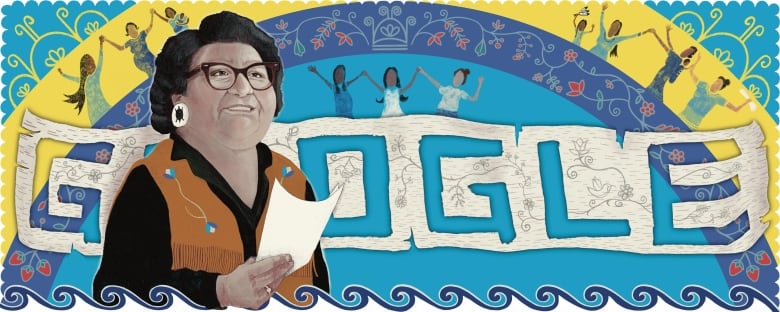

Mary Two-Axe Earley’s advocacy spanned three decades, trailblazing a movement for Indigenous women’s rights, but supporters say her legacy is still unknown by many Canadians.
It’s why she’s the focus of today’s Google doodle. Google doodles are the changes that are made to the Google logo to celebrate holidays, anniversaries and the lives of famous artists, pioneers and scientists.
“Mary is just such an important figure in Canadian history,” said Courtney Montour, a Kanien’kehá:ka (Mohawk) filmmaker from Kahnawake, south of Montreal.
“It’s time that her story becomes more well-known.”

June 28 marks 36 years since Bill C-31 received royal assent in 1985, amending the Indian Act to allow a process of reinstatement for Two-Axe Earley and thousands of other First Nations women and their children who had lost their status due to longstanding gender-based discrimination within the act.
Prior to 1985, women with Indian status who married a non-status man lost their status, and their children were denied status. Indian status was passed down almost exclusively through men.
Two-Axe Earley died in 1996 at the age of 84. Montour wrote and directed the documentary Mary Two-Axe Earley: I Am Indian Again, the first film to document her life and legacy, which premiered at the Hot Docs festival this spring. The two are from the same community, as is the artist who illustrated the doodle.

Star Horn’s illustration features Two-Axe Earley’s portrait with detailed symbols and imagery of Kanien’kehá:ka culture. The rapids present Kahnawake’s namesake, there’s birch bark, floral beadwork, sky domes as a nod to the creation story, and a reminder of the countless women she impacted across Canada.
“I wanted her family to be proud of it,” said Horn.
“I wanted them to know how important she is, what she means to everybody. I wanted people to know her impact.”

Google has created over 4,000 doodles for its homepages around the world.
“Aside from trying to surprise and delight Canadians, we try to use it as a mechanism to start a conversation, reflect Canada back to Canadians and educate about somebody new who they might not know was an extremely impactful leader like Mary Two-Axe Earley,” said Alexandra Klein, spokesperson for Google Canada.
Two-Axe Earley helped establish the Equal Rights for Indian Women organization, was a founding member of the Quebec Native Women association, and spent much of her life fighting gender-based discrimination within the Indian Act.

A fight that is still ongoing according to many Indigenous women’s activists.
The national inquiry into missing and murdered Indigenous women recognized gender-based discrimination in the Indian Act as one of the root causes of violence Indigenous women face in Canada, and called for the elimination of remaining discrimination in the act.
For Montour, the Google doodle will help make Two-Axe Earley’s story more accessible.
“It’s so important that it’s going to have this reach across Canada,” said Montour.
“I just want more people to get to know her name and understand that this isn’t something of the past. There’s more work that needs to be done.”












